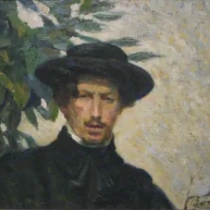 1882 - 1916
futurism
1882 - 1916
futurism
Description Umberto Boccioni
Umberto Boccioni, born in 1882 in Reggio Calabria, Italy, emerged as a luminary of the Futurist movement, reshaping the contours of modern art. His journey unfolded against the backdrop of Italy's dynamic socio-political landscape, capturing the spirit of a nation hurtling towards an industrialized future.
Boccioni's artistic odyssey commenced with academic training in Rome and later Milan. However, it was the encounter with Filippo Tommaso Marinetti and the Futurist manifesto that ignited his revolutionary fervor. Boccioni became the visual provocateur of this movement, advocating for the embrace of technology, speed, and dynamism.
His "Manifesto of Futurist Painters" laid the groundwork for a new visual vocabulary. Boccioni, along with other Futurists, sought to liberate art from the shackles of tradition, celebrating the energy of modern life. His paintings, like "The City Rises" and "Dynamism of a Cyclist," depicted bustling urban scenes and human figures in a dynamic interplay of form and movement.
Boccioni's contribution extended beyond painting. As a sculptor, his exploration of space and movement reached its zenith with the iconic "Unique Forms of Continuity in Space." This bronze sculpture, with its aerodynamic contours, embodied the Futurist fascination with speed and progress.
His intellectual rigor found expression not only in visual art but also in theoretical writings. Boccioni delved into the philosophical underpinnings of Futurism, emphasizing the interconnectedness of art, technology, and society. His ideas on the "synthesis of the unique form" became central to Futurist aesthetics.
World War I marked a somber chapter in Boccioni's life. Enlisting voluntarily, he experienced the harsh realities of warfare. Tragically, his life was cut short in 1916 when he fell from his horse during a cavalry training exercise.
Umberto Boccioni's legacy endures as a transformative force in the annals of modern art. His commitment to capturing the essence of a rapidly evolving world, infused with the spirit of Futurist ideology, resonates through his paintings and sculptures. Boccioni's avant-garde vision, though brief, left an indelible mark on the trajectory of 20th-century art, embodying the exhilarating dance between tradition and progress.
Gallery
Paintings Umberto Boccioni
Quotes
The only way to give form to the new art will be to destroy the old one.
I want to make a painting of the kind of soul I carry inside me.
We declare that the splendor of the world has been enriched by a new beauty: the beauty of speed.
I am convinced that art must be constantly renewed through new forms and constructions.
Let us rebel against the great deception of modern society, against everything which surrounds us and in which we are entangled.

No Comments Yet...